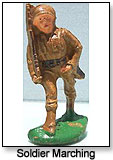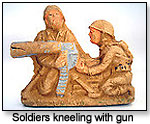
November 21, 2024


 At the Playwood Plastics factory, mold-making and figure sculpting of the Playwood Plastics soldiers were entrusted to Max Peinlich (pronounced PINE-lick), an Austrian living in White Plains, New York, who was in his 60s or 70s at the time. Weiss does not know where Peinlich got his ideas, but from the look of the soldiers, it could have been from his grandchildren’s Manoils.
At the Playwood Plastics factory, mold-making and figure sculpting of the Playwood Plastics soldiers were entrusted to Max Peinlich (pronounced PINE-lick), an Austrian living in White Plains, New York, who was in his 60s or 70s at the time. Weiss does not know where Peinlich got his ideas, but from the look of the soldiers, it could have been from his grandchildren’s Manoils.
The composition of Playwood’s soldiers consisted of triple zero wood flour from Wisconsin (very fine-ground, almost like talc), 20 Mule Team Borax, unbleached white flour (condemned by food inspectors who had marked the inedible flour with chicken blood), and water. The flower and water, of course, provided the glue binder. The blend was mixed in a high-speed dough mixer, and then extruded into bars 3” wide and about 1-1/2” thick. These were cut into strips and fed through a hydraulic press that stamped out the soldiers, rather like cookies. The soldiers were then placed in wire trays and put into 8-foot high hot air bins, where they were cured. After their edges were buffed, they went into a centrifugal machine that coated them with paint, and then onto a production line, where the details were hand-painted.
Although the selling office was located at 200 Fifth Avenue, the factory was at 133 Floyd Street, Brooklyn, formerly the home of Sklar surgical instruments. Originally Roth, Smith and Transogram went in on a 50-50 basis, but Roth and Smith had virtually no financing and Transogram eventually took over completely, entering into an employment contract with Roth and Smith (Smith was later fired), and with Weiss in full charge of production.
 The company was successful for a time, employing 125 people, but never went beyond its original complement of (as Weiss recalls) 12 to 15 soldiers – partly because they were too busy, and partly because finding metal for the molds was too difficult. However, as the war ended and metal soldiers began to return, Playwood’s days were numbered. It hung on for awhile after the war, making such things as composition fingers with nails to be used with nail polish displays in cosmetics stores, but was eventually closed down by Transogram. No catalogs have yet surfaced, but ones with the figures illustrated were issued by the company. Each soldier was numbered. Known numbers and poses are listed below, along with a few photos of the soldiers themselves.
The company was successful for a time, employing 125 people, but never went beyond its original complement of (as Weiss recalls) 12 to 15 soldiers – partly because they were too busy, and partly because finding metal for the molds was too difficult. However, as the war ended and metal soldiers began to return, Playwood’s days were numbered. It hung on for awhile after the war, making such things as composition fingers with nails to be used with nail polish displays in cosmetics stores, but was eventually closed down by Transogram. No catalogs have yet surfaced, but ones with the figures illustrated were issued by the company. Each soldier was numbered. Known numbers and poses are listed below, along with a few photos of the soldiers themselves.
 401 Marching slope in helment
401 Marching slope in helment
402 Marching slope in softcap
403 2-man machine-gun team
404 Stretcher bearer
405 Probably a wounded man
406 Gasmasked with flaregun overhead
407 *
408 Lying with machine gun
409 *
410 Kneeling with anti-tank gun
* 407 and 409 are Motorcycle & Advancing with Machine Gun, but numbers are not disctinct enough to say which is which.
Copyright © 2024 TDmonthly®, a division of TOYDIRECTORY.com®,
Inc.